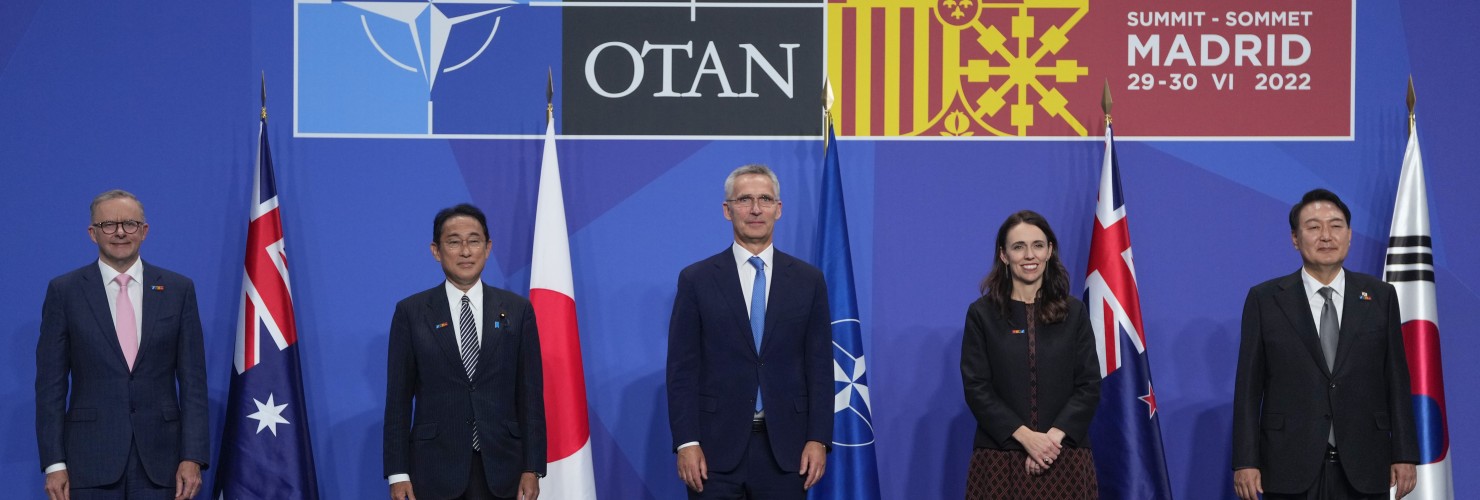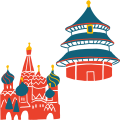

China and Russia bring NATO and the Indo-Pacific together
Beijing’s siding with Moscow after the invasion of Ukraine has brought about an alignment on China within the transatlantic alliance, says Helena Legarda.
The Indo-Pacific is a long way from Madrid, but at the most recent NATO summit held in the city, it played a very prominent role. The leaders of NATO’s four Indo-Pacific partners—the “Asia-Pacific Four” (AP4) South Korea, Japan, Australia, and New Zealand—were invited for the first time to attend this decisive summit, where allies endorsed a new Strategic Concept. This roadmap for NATO’s next decade maintains a strong focus on Russia as the most direct threat to the alliance, but it also addresses the “systemic challenges” posed by China, which is a first.
Despite the focus on Russia amid the ongoing war in Ukraine, the Indo-Pacific has now firmly entered the NATO horizon. China’s partnership with Russia, together with Beijing’s decision not to distance itself from Moscow after the invasion, have played a key role in highlighting the linkages between the European and Indo-Pacific theaters. This may lead to an increased presence of individual NATO allies in the Indo-Pacific, in cooperation with regional partners—an outcome that China had sought to prevent.
The China-Russia factor
All NATO allies share a growing concern about China’s geopolitical rise and power projection capabilities, as well as the impact that these may have on the rules-based international order and the global balance of power.
Today, China is not only taking a central role in Indo-Pacific security affairs, but it is also becoming an increasingly visible security actor in Europe and its periphery. And Beijing’s “strategic partnership” with Russia, reaffirmed even in the face of Russia’s invasion of Ukraine, plays a key role in shaping many allies’ threat perceptions. Joint Sino-Russian military exercises in both Europe and East Asia over the last few years have become a particular point of concern for nations in both theaters.
NATO’s role in confronting any security challenges posed by China in the Euro-Atlantic area is evident. But what—if any—the alliance’s role in the Indo-Pacific should be has long been a contentious point.
Some NATO members, such as the United States, the United Kingdom, and France, maintain a regular military presence in the Indo-Pacific, while others do not see the need to deploy to Asia now that Russia has revealed itself as a clear and direct threat to Europe and/or do not have the capabilities. But what seems clear is that the alliance will not operate collectively in the Indo-Pacific any time soon. “There’s no way that NATO will move into the South China Sea,” according to NATO Secretary General Jens Stoltenberg.
How, then, does the alliance plan to “stand up for our shared values and the rules-based international order, including freedom of navigation” in the face of China’s “stated ambitions and coercive policies”, especially in the Indo-Pacific?
Enter the global partners
The answer is more about a global approach than a global presence. And cooperation with NATO’s global partners in the Indo-Pacific region is a central piece of the puzzle.
The presence of the “Asia-Pacific Four” in Madrid is a step toward this goal. It is also a clear sign that NATO allies and their Indo-Pacific partners share the concerns over Russia and China’s behavior on the international stage.
While the security challenges that NATO allies face today are quite different from those that partners in the Indo-Pacific must confront, there seems to be a realization on both sides that closer cooperation is the only way to effectively protect the rules-based international order. Asian partners have condemned Russia’s invasion of Ukraine and have imposed sanctions on Moscow in response. And in return, they seek to secure NATO (including European) support for any potential conflicts in Asia. Japanese Prime Minister Fumio Kishida put it most plainly in Madrid, “I feel a strong sense of crisis that Ukraine may be East Asia tomorrow.”
Despite fears that the Western sanctions policy is bringing China and Russia closer together, the fact is that Sino-Russian alignment is also unifying NATO and moving Euro-Atlantic countries closer together with their allies and partners in the Indo-Pacific. Unintentionally, Beijing and Moscow have managed to draw the linkages between Euro-Atlantic and Indo-Pacific security that they had long fought against.
Mind the divergences
Despite this show of unity in Madrid, however, the newly forged alignment on China among NATO allies and with global partners should not be overstated. There may now be a common threat perception, but when it comes to responses, there is a wide diversity of views and approaches.
Within Europe, the perspective that systemic rivalry should be the dominant framework through which relations with China are viewed is not fully shared. And the US view of China as the “pacing threat” has many opponents within NATO, especially in Central and Eastern Europe, for whom Russia is instead the main challenge. Others, like Germany and France, have pushed back against attempts to lump together Russia and China (something Chancellor Olaf Scholz’ foreign policy advisor Jens Plötner warned against publicly), and to consider them as equal threats.
Divergences also exist among NATO’s Indo-Pacific partners, who have very different foreign policies and views of China, as well as their own unique interests in pursuing greater coordination with NATO. Australia and Japan, both members of the Quad (the others are the United States and India), are the most closely aligned with Washington when it comes to relations with China, although they have both emphasized the need to maintain stable ties with Beijing.
Attempts by the Chinese leadership to bring about a thaw in relations with Australia after the election of Prime Minister Anthony Albanese seem to be going nowhere, however, as Canberra has signaled a continuation of the previous government’s tough stance on China. Foreign Minister Wang Yi’s delivery of a list of demands to rebuild the relationship—which included “regarding China as a partner rather than a rival” and “not targeting any third party or being controlled by any third party” (a clear reference to the US)—drew an immediate response from Albanese who bluntly stated, “Australia doesn't respond to demands.”
And in Japan, Prime Minister Kishida Fumio has taken a harder stance on China’s activities in the region and continues to invest in Japan’s alliance with the US (which he has called the “cornerstone” of Japan’s security policy) in order to increase deterrence against China.
But while these two Quad members are seen in Beijing as being firmly on the US camp, New Zealand and South Korea are a different story. Prime Minister Jacinda Ardern’s government has indicated that New Zealand has no intention of joining any coalition targeting China. And the country’s close economic ties with China, alongside a longstanding principle of maintaining an independent foreign policy, are likely to constrain any potential shifts on China policy.
South Korea, meanwhile, sees China as less of a priority than North Korea and its nuclear program or the protection of its economic security. Newly elected President Yoon Suk-yeol has articulated a vision for his country as a “global pivotal state” that will pursue a values-based foreign policy, and he has announced that South Korea will launch its own Indo-Pacific strategy by the end of this year. But while Seoul is talking the talk, South Korea’s "pragmatic" approach to relations with Beijing, which seeks to avoid antagonizing China to prevent economic retaliation, runs deep. Besides, the role of South Korea-Japan tensions can’t be underestimated: close cooperation on China between Seoul and Tokyo still seems out of reach.
The way ahead
Full alignment on approaches to China (or Russia) within NATO and with the alliance’s Indo-Pacific partners is highly unrealistic. Not all countries see China as an equally pressing challenge. And even among those that do, the policy prescriptions vary, ranging from close alignment with the US as a deterrent against Chinese aggression, to attempts to maintain good relations with Beijing in the hope of shaping its actions and encouraging China to behave more responsibly.
The upswing in engagement with Indo-Pacific partners, alongside NATO’s inclusion of the European Union as a “unique and essential partner” in its Strategic Concept, however, will create new opportunities and formats for cooperation and coordination across regions and institutions.
It is important, however, to distinguish between NATO’s potential collective involvement in the Indo-Pacific and that of its member states. While the former remains exceedingly unlikely (in spite of Beijing’s claims), individual allies may leverage the alliance’s growing engagement with its global partners to step up their own presence in the region.
Beijing has sought to discourage European countries and other NATO members from becoming more involved in the region, cautioning them against doing anything that could “harm regional peace and stability” and warning of consequences. We should expect a harsh response from Beijing as it adapts to new dynamics of cooperation between NATO members and their regional partners.
This article was first published by Internationale Politik Quarterly on July 14, 2022.


